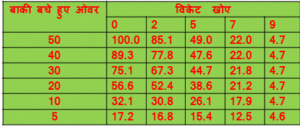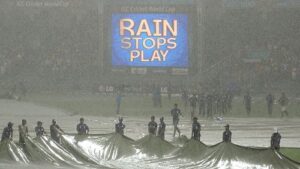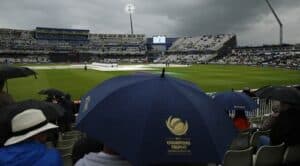At present, the game of cricket has become popular in India as well as in many countries of the world, and spectators enjoy this game through various mediums. But sometimes the cricket game gets interrupted due to rain. To get results in ODI and T-20 matches affected by rain, a rule is used, which is called the Duckworth-Lewis rule. In this article, we are giving a detailed description of the Duckworth-Lewis rule and how it is used in cricket.
The Duckworth-Lewis method calculates the score needed to tie or win in the event of match interruption (usually because of weather).
Inventor of Duckworth Lewis rule
The statisticians Frank Duckworth and Tony Lewis are credited with creating the Duckworth-Lewis rule, which bears their names.
The Duckworth-Lewis rule was used for the first time in international cricket in the match between Zimbabwe and England in 1996-97. In this match, the Zimbabwe team won by 7 runs under Duckworth Lewis rule. The ICC formally adopted the Duckworth-Lewis method system in 1999 for setting objectives in rain-affected One-Day International matches.
In November 2014, following the retirement of Frank Duckworth and Tony Lewis, Steve Stern was appointed custodian of the Duckworth Lewis Rule and the rule was renamed the Duckworth Lewis Stern Rule.
How to use Duckworth-Lewis-Stern rule?
According to Duckworth Lewis Stern rule, in the game of cricket, both the teams have two means to score maximum runs – total overs remaining and wickets remaining. The ability of teams to score runs at any point of the match depends on these two means. On the basis of this, Frank Duckworth and Tony Lewis have prepared a list which shows what percentage of resources are left with the team batting at different stages of the match.
List of Duckworth Lewis Stern rules
Looking at this list clearly shows that at the time of the start of the innings, when there are 50 overs and 10 wickets remaining, the means of scoring runs are also 100 percent. After this, as the team keeps using its overs and losing wickets, its resources also reduce accordingly.
If a team has played 20 overs in the match and 30 overs are left, and 2 wickets have also fallen, then in such a situation that team will have 67.3 percent resources left. Now in this situation it rains and 10 overs are wasted until the game starts again. This means that now that team has only 20 overs left and has lost 2 wickets, then according to the list, in this situation that team will have 52.4 percent resources left.
Now to find out how many resources this team has lost, let us first see how many resources it had left when the rain started and how many resources it had when the game started again.
In the above case, when the rain started, 67.3 percent resources were left and when the game started again, 52.4 percent resources were left.
That means the team suffered a loss of 67.3 – 52.4 = 14.9 percent of its resources.
Since the team was to get 100 percent of the total resources, out of which 14.2 percent has been wasted, this team has used 100 – 14.2 = 85.8 percent of the resources.
Now, for justice to be done to both teams, it is necessary that they get equal resources. For this, if rain affects the team batting later, then under the above rule, its target is reduced, and if rain affects the team playing first, then its target is increased.
You will easily understand the Duckworth-Lewis-Stern rule through the three examples given below:
Example 1. If rain affects the team batting later and the match cannot be played further
Suppose the first team scored 300 runs in 50 overs and the second team had scored 250 runs losing 5 wickets in 40 overs by the time the rain arrived. After this no play can take place in the match. Therefore, Duckworth Lewis Stern rule will be adopted to find the winner of the match.
The first team played its entire 50 overs, that is, it used its full 100 percent resources. The other team also had 100 percent resources at the beginning of the innings. After 40 overs, the other team has 10 overs left and has lost 5 wickets. According to the Duckworth Lewis Stern list, in this situation, the team batting later has 26.1 percent resources left. Since the entire subsequent game has now been cancelled, that means the team batting later has lost 26.1 percent of its resources.
That means he used 100 – 26.1 = 73.9 percent resources.
Since the second team got less resources than the first team, the target of the second team will also have to be reduced in proportion to the resources.
The first team had scored 300 runs, that means now the target of the second team will be 300 x 73.9 / 100 = 221.7 runs.
Since the other team needed 222 runs to win, but had already scored 250 runs, thus under the Duckworth-Lewis-Stern rule, the other team won the match by 28 runs.
How does the Lewis-Duckworth calculator work?
The dls calculator determines target (and results) by figuring out how many runs teams should have scored—and would have scored—if both sides had had the same amount of resources. In order to compute a goal, the formula can be phrased as follows: Team 1’s score x (Team 2’s resources / Team 1’s resources) equals Team 2’s par score.
Example 2. If rain affects the team batting later and the match resumes after some time
In the match described in Example 1, suppose rain stops and 5 overs are lost. Since the rain started, the other team had scored 250 runs for 5 wickets in 40 overs, that is, they had 10 overs left and according to the Duckworth Lewis Stern list, they had 26.1 percent resources left at that time. When the game starts again, he now has 5 overs and 5 wickets left, that is, he has 15.4 percent resources left.
This means that the other team lost 26.1 – 15.4 = 10.7 percent of the resources and is getting a total of 100 – 10.7 = 89.3 percent of the resources.
Thus, once again the second team is getting less resources than the first team, hence the target of the second team will have to be reduced and its new target will be 300 x 89.3 / 100 = 267.9 runs.
Therefore, the other team will now have to score 268 runs to win. Since it has scored 250 runs after losing 5 wickets, now it will have to score 268 – 250 = 18 runs in 5 overs.
Example 3. If rain affects the team batting first
Suppose the team playing first has scored 200 runs for 7 wickets after 40 overs and rain comes, due to which time is wasted and the innings of the first team is ended on this score. Now the other team will also be given only 40 overs to achieve this target but their target will be new.
According to the Duckworth-Lewis list, when the first team’s innings ended, it had 17.9 percent resources left, that is, it used 100 – 17.9 = total 82.1 resources.
Now the other team is also getting only 40 overs whereas it should have got 50 overs, that is, it is also suffering a loss of 10 overs from the very beginning.
According to the Duckworth Lewis list, the other team has 40 overs and has not lost any wicket, that is, it is getting 89.3 percent resources.
That means it is getting 89.3 – 82.1 = 7.2 percent more resources than the first team, hence its target will also have to be increased by 7.2 percent.
According to the new ICC rules, the average score of an ODI match of 50 overs is 225.
Hence, the other team will now have to score 7.2 percent of 200 + 225 i.e. 200 + 16.2 = 216.2 = 217 runs.
Finally it can be said that through the above description, one can easily understand the Duckworth Lewis Stern rule and in future when a match is interrupted by rain, one can assess for oneself whether the match will be played or not. Which team has the upper hand?




